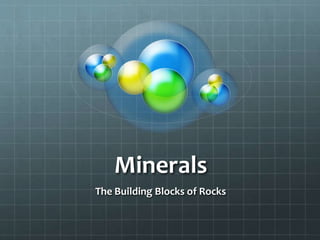
Minerals - What are they?
- 1. Minerals The Building Blocks of Rocks
- 2. What are minerals made of? • Most minerals are made up of a combination of two or more elements. • Elements such as Na, Ca, Fe, Mg, O, Si, Al, K – and others that you might recognize from the periodic table of elements. • These elements combine together to form minerals. • Minerals then combine in different ways to form rocks.
- 3. Minerals • All Minerals are made up of single elements or compounds. • Element: An element is made up of atoms, and cannot be broken down into a simpler substance. • Compound: A compound contains 2 or more kinds of atoms that are bonded (joined) together. • Atom: An atom is the smallest part of an element – it has all of the properties of the element, but cannot be seen – even with tools.
- 4. A naturally occurring, inorganic solid crystalline substance with a definite chemical composition. A mineral must have these 5 major aspects: If even just one of these requirements are not satisfied, then the substance is NOT a mineral. 1 •Naturally Occurring 2 •Inorganic 3 •Solid 4 •Crystal 5 •Definite Chemical Composition 4000 Mineral on Earth
- 5. Naturally Occurring • Something formed in nature, NOT MAN-MADE • Example: Diamond, Copper, Salt Minerals are a girl’s best friend! • Diamonds are mineral • Cubic Zirconia is not because it is synthetic Which one is a Diamond?
- 6. Inorganic • Something that was never living. Or originated from a living organism. • An inorganic substance was formed by earth processes. Is ice inorganic? Is paper inorganic? Is rock from magma inorganic? Is a dead cat inorganic? Are synthetically created substance minerals? After all, they were never alive?
- 7. Solid • Something that has a definite, ridged shape and volume. • Gas and liquids are not minerals. Is air a mineral? Is mercury a mineral?
- 8. Crystalline Substance • A crystal is a substance whose atoms are arranged in a orderly pattern. • Particles line up in a pattern that repeats over and over again…called a crystal • A crystal has flat sides called faces.
- 10. Crystalline Substance • There are 7 Crystal Systems Cubic Tetragonal The cube is composed of 6 square faces at 90° angles to each other. Each face intersects one of the crystallographic axes and is parallel to the other two. The tetragonal system also has three axes that all meet at 90°. It differs from the isometric system in that the C axis is longer than the A and B axis which are the same length.
- 11. Crystalline Substance • There are 7 Crystal Systems Hexagonal Trigonal In the hexagonal system we have an additional axes, which gives the crystals six sides. Three of these are equal in length and meet at 60° to each other. The C or vertical axis is at 90° to the shorter axes. Mineralogists sometimes divide this into two systems, the hexagonal and the trigonal, based on their external appearance, as follows: Again, the trigonal system is a subsystem of the hexagonal. Most gem references will list these as hexagonal.
- 12. Crystalline Substance • There are 7 Crystal Systems Orthorhombic Monoclinic In this system there are three axes, all of which meet at 90° to each other. However, all the axes are a different length. The above crystal systems all have axes sides that meet at 90°. In the monoclinic system all the axes are different lengths. Two of them, the A and C axes, meet at 90°, but the third one does not.
- 13. Crystalline Substance • There are 7 Crystal Systems Triclinic In this system all the axes are different lengths and none of them meet at 90°.
- 14. Definite Chemical Composition • Every mineral has its own chemical composition. • A chemical composition is like a recipe for baking. • A mineral has certain elements combined in certain amounts. Just like baking, the ingredients must be in the right amounts for it to turn out the way the recipe intended. Na + Cl = NaCl (Salt) Si + O2 = SiO2 (Quartz) Si + O2 is not the same as Si + O3 Substance 1 •1 Egg •1 cup flour •1cups sugar Substance 2 •3Eggs •2cup Flour •4cups sugar
- 15. Review 1. A mineral is said to be … NATURALLY OCCURRING because they formed by processes that occur in the natural world. 2. Complete the concept map below… 3. In your own words, write a definition of a mineral. A solid crystal that was never alive or apart of a living organism that formed naturally and has a certain chemical composition. Inorganic Solid Crystal Definite Chemical Composition
- 16. Review 4. Because minerals do not come from living things, they are said to be… inorganic. 5. A substance that keeps its shape because its particles cannot flow freely is a(n)... SOLID. 6. A solid with flat sides that meet at sharp edges and corners is called a(n)... CRYSTAL.